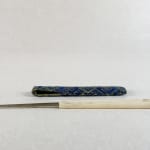







artisan's name unknown
Chopstick with Blue Case, Taisho Era (1912-1926)
Woven Silk (case);
Ivory and Steel (Chopsticks)
Ivory and Steel (Chopsticks)
1/2" x 4"
Further images
-
(View a larger image of thumbnail 1
)

-
(View a larger image of thumbnail 2
)

-
(View a larger image of thumbnail 3
)

-
(View a larger image of thumbnail 4
)

-
(View a larger image of thumbnail 5
)

-
(View a larger image of thumbnail 6
)

-
(View a larger image of thumbnail 7
)

-
(View a larger image of thumbnail 8
)

During the late Meiji to Taisho period (1912 - 1926) , a new industry that produced and dealt with fukuromono 袋物, meaning purses or pouches in Japanese, appeared. At its...
During the late Meiji to Taisho period (1912 - 1926) , a new industry that produced and dealt with fukuromono 袋物, meaning purses or pouches in Japanese, appeared. At its beginnings, fukuromono were tobacco pouches for men that had recently come into fashion. In the Meiji period (1868-1912), they slowly spread to women and the variety of fukuromono blossomed to include a wide range of accessories like purses, clutches, and cases. The intricacy and high level of craftsmanship of fukuromono for women in the era would be the last flare before its extinction. This coincided with the beginning of the decline of the Kimono industry and its craft.
The woven silk case was used to carry a pair of hibashi (chopsticks used to pick up small pieces of hot charcoal) when attending an incense-burning ceremony. Its understated design reflects the refined, elegant styles that had developed around this time. Both the shimmering green and brown silk threads that are used to create the geometric pattern, and the quiet green lining on the interior of the pouch, complements the blue thread wonderfully. Inside the case there is a collapsible pair of chopsticks of the highest quality, made with ivory and steel.
The work is a symphony of simplicity in design, and masterful techniques in weaving, stitching, and forging metal. For those who are environmentally conscious, it could be used today as a wonderful, reusable portable pair of chopsticks.
The woven silk case was used to carry a pair of hibashi (chopsticks used to pick up small pieces of hot charcoal) when attending an incense-burning ceremony. Its understated design reflects the refined, elegant styles that had developed around this time. Both the shimmering green and brown silk threads that are used to create the geometric pattern, and the quiet green lining on the interior of the pouch, complements the blue thread wonderfully. Inside the case there is a collapsible pair of chopsticks of the highest quality, made with ivory and steel.
The work is a symphony of simplicity in design, and masterful techniques in weaving, stitching, and forging metal. For those who are environmentally conscious, it could be used today as a wonderful, reusable portable pair of chopsticks.
Signup for our Newsletter
You will receive two emails a month from us. One introduces artworks and design works from Kyoto's hidden sources and the other is stories from Misako, sharing insights into Japanese culture.
* denotes required fields
为了回应您的查询,我们将根据我们的隐私政策处理您提供的个人数据。